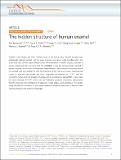The hidden structure of human enamel
Author(s)
Jung, Gang Seob; Qin, Zhao; Buehler, Markus J.
DownloadPublished version (3.878Mb)
Publisher with Creative Commons License
Publisher with Creative Commons License
Creative Commons Attribution
Terms of use
Metadata
Show full item recordAbstract
Enamel is the hardest and most resilient tissue in the human body. Enamel includes morphologically aligned, parallel, ∼50 nm wide, microns-long nanocrystals, bundled either into 5-μm-wide rods or their space-filling interrod. The orientation of enamel crystals, however, is poorly understood. Here we show that the crystalline c-axes are homogenously oriented in interrod crystals across most of the enamel layer thickness. Within each rod crystals are not co-oriented with one another or with the long axis of the rod, as previously assumed: the c-axes of adjacent nanocrystals are most frequently mis-oriented by 1°–30°, and this orientation within each rod gradually changes, with an overall angle spread that is never zero, but varies between 30°–90° within one rod. Molecular dynamics simulations demonstrate that the observed mis-orientations of adjacent crystals induce crack deflection. This toughening mechanism contributes to the unique resilience of enamel, which lasts a lifetime under extreme physical and chemical challenges.
Date issued
2019-09-26Department
Massachusetts Institute of Technology. Department of Civil and Environmental Engineering; Massachusetts Institute of Technology. Laboratory for Atomistic and Molecular MechanicsJournal
Nature communications
Publisher
Springer Science and Business Media LLC
Citation
Beniash, Elia et al. "The hidden structure of human enamel." Nature communications 10 (2019): 1038 © 2019 The Author(s)
Version: Final published version
ISSN
2041-1723
Keywords
General Biochemistry, Genetics and Molecular Biology, General Physics and Astronomy, General Chemistry